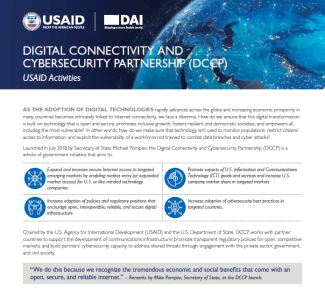Mobile and digital technologies have revolutionized the way we interact with the world around us. Thanks to the rapid proliferation of these technologies, we are more globally connected and open to innovative ideas than ever before.
Yet despite the unprecedented expansion of digital technologies over the last decade, approximately 1 in 3 people in areas USAID works in are not online—leaving over 4 billion people without the life-changing opportunities that the internet provides. This digital divide limits women’s empowerment, slows economic growth, leaves communities at risk of instability, and closes the door to innovation in education, health, governance, and other services essential for countries to continue their journey to self-reliance.
The Technology DIvision's Digital Inclusion practice, within the Bureau for Development, Democracy, and Innovation works to expand connectivity and digital access by providing technical assistance, driving inclusive policy and infrastructure development, and creating tools and model performance indicators that both Missions and private investors can use to facilitate investment into new connectivity business models and support countries on their journey to self-reliance.
Spotlight:
Advancing Digital Connectivity and Cybersecurity USAID’s Digital Inclusion practice supports the implementation of the Digital Connectivity and Cybersecurity Partnership (DCCP), a whole-of-government initiative supporting the development of communications infrastructure; promoting transparent regulatory policies for open, competitive markets; and building partners’ cybersecurity capacity to address shared threats.
Improving Connectivity for Development To empower countries on their journey to self-reliance and support economic and social growth, development programs require access to affordable, reliable connectivity services. In this guide, USAID’s Digital Inclusion practice outlines how USAID Missions, governments, and service providers can work together to find market-based solutions to overcome barriers to these critical services.
Supporting Last-Mile Connectivity USAID’s Digital Inclusion practice works to connect marginalized communities to ensure full participation in the digital economy, positively impact household income and social development, and improve development services delivery. See our report on how to connect the 4 billion people who still lack access to digital services.
Closing the Digital Gender Divide Despite the rapid growth and integration of digital tools, 1.7 billion women in low- and middle-income countries remain unconnected. To address this digital gender divide, the Digital Inclusion practice supports USAID’s WomenConnect Challenge, seeking innovative solutions to close the divide. To learn more, please visit the Challenge’s homepage.
The Women in the Digital Economy Fund (Wi-DEF) is a joint effort between USAID and the Bill & Melinda Gates Foundation to accelerate progress on closing the gender digital divide. USAID will commit up to $50 million in Gender Equity and Equality Action (GEEA) fund resources, subject to the availability of funds, and the Gates Foundation will commit $10 million by the end of 2026, with at least half of each of these commitments focused on Africa. In addition to its commitment to Wi-DEF, the Gates Foundation has committed to invest $40 million toward closing the digital gender divide in Africa and South Asia. Wi-DEF will accelerate progress to close the gender digital divide by scaling evidence-based, proven solutions, including women-led solutions that improve women’s livelihoods, economic security, and resilience. This work will focus on programs that support digital access and affordability; the design and development, especially women-led development, of relevant products and tools; digital literacy and skills training; online safety and security; and sex-disaggregated data and research.
Empowering Local Communities Working with the Indonesian government to draft and launch a 5-year national broadband plan, USAID’s Digital Inclusion practice supports the creation of a nationwide fiber optic network. This project has connected over 140,000 schools and 5,000 health clinics.
Learn more about the Digital Connectivity and Cybersecurity Partnership (DCCP).

